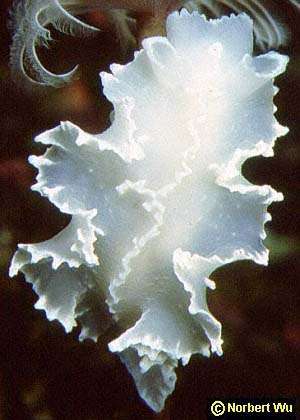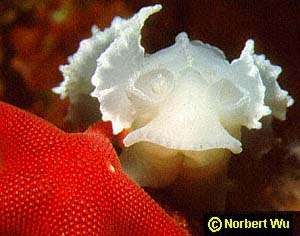

Tritoniella belli
Eliot, 1907
Order: NUDIBRANCHIA
Suborder: DENDRONOTINA
Family: Tritoniidae
DISTRIBUTION
Known from all around Antarctica and the sub-antarctic islands of South Georgia, from 18 - 700 metres.
PHOTO
McMurdo Sound, Antarctica. This photo is published with the permission of Norbert Wu from the Underwater Field Guide to Ross Island & McMurdo Sound, Antarctica . In the lower photo Tritoniella belli is crawling across the seastar Odontaster validus.
Tritoniella is a monotypic genus found only in Antarctic and adjacent waters. The single species, Tritoniella belli, can grow to 8 cm long, and range in colour from the milky-white or translucent, like the specimens photographed here from McMurdo Sound, and reported from the Weddell Sea, to yellow or orange in specimens from the Antarctic Peninsula. The mantle edge is wavy and can be smooth or with finger-like processes. These processes can appear and disappear in the lifetime of an animal. Most animals have a longitudinal median ridge down the back. In specimens from the Antarctic Peninsula the back is usually covered with tubecles, but elsewhere it is usually smooth.
T. belli is usually found feeding on the stoloniferan soft coral Clavularia frankliniana, but it is thought to also sometimes eat hydroids and anemones. It has also been reported to feed on the soft coral Ascolepis sp..
Chemical studies suggest that Tritoniella belli probably defends itself chemically against predators by using chimyl alcohol that it obtains from its food, the soft coral Clavularia frankliniana. T. belli mantle tissue is noxious to the sea urchin Sterechinus neumayeri, several starfish, including Odontaster validus (photographed above), and some fish [4].
References:
• Barnes, D.K.A. & Bullough, L.W. (1996). Some observations on the diet and distribution of nudibranchs at Signy Island, Antarctica. Journal of Molluscan Studies 62, 281-287.
• McClintock, J.B., Slattery, M., Heine, J., Weston, J. (1992) Chemical defense, biochemical composition and energy content of three shallow-water Antarctic gastropods. Polar Biology, 11(8): 623-629.
• McClintock, J.B., et al. (1994) Chemical defense of common antarctic shallow-water nudibranch Tritoniella belli Eliot (Mollusca: Tritonidae) and its prey, Clavularia frankliniana Rouel (Cnidaria: Octocorallia). Journal of Chemical Ecology,20(12): 3361-3372.
• Wagele, H. (1989) On the anatomy and zoogeography of Tritoniella belli Eliot, 1907 (Opisthobranchia, Nudibranchia) and the synonymy of T. sinuata Eliot, 1907. Polar Biology 9: 235-243.
• Wagele, H. (1989) Diet of some Antarctic nudibranchs (Gastropoda, Opisthobranchia, Nudibranchia). Marine Biology 100: 439-441.
Rudman, W.B., 1999 (February 14) Tritoniella belli Eliot, 1907. [In] Sea Slug Forum. Australian Museum, Sydney. Available from http://www.seaslugforum.net/factsheet/tritbell
Related messages
-
Tritoniella belli from King George Island, Antarctica
From: Bill Rudman, March 20, 2007
